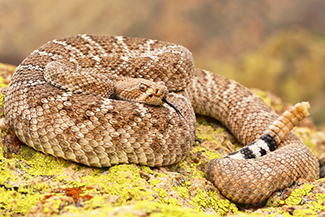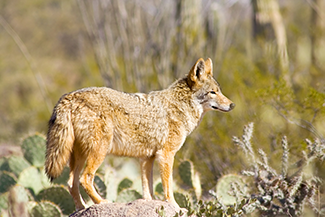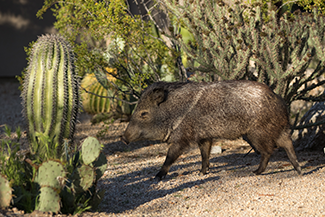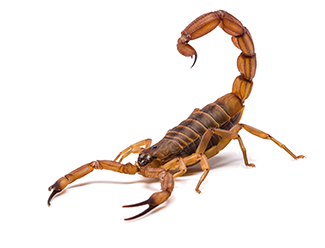Protecting Pets From the Naughty Side of Nature
 07 September 2021
07 September 2021 

Protecting Pets From the Naughty Side of Nature
Arizona is home to an assortment of stunning and mysterious wildlife and plantlife.
As beautiful as the Arizona desert is, there are threats to your pets that you need to be aware of; animals on the prowl, plants that hurt, and a virus that could prove fatal. The Arizona Game & Fish Department, Carrie Pawpins, Animal & Surgical Center of North Scottsdale, PetMD, and the American Kennel Club offer these preventive measures. You will want to find the problem before your pets do.
General Pet Safety Tips
- The Most Important of All -- NEVER feed wild animals other than birds. Feeding can cause them to become regular visitors and lose their fear of people.
- Keep your cats indoors, no matter how much they beg to go outside.
- Never let dogs outside unattended.
- Close and secure doggy doors at night.
- Build a sturdy, fully enclosed dog run or catio (including a roof and secure latch.)
- Keep pets leashed when walking.
- Don’t walk in desert areas around dusk and dawn. Wildlife is more active at those times.
- Teach your dog a “leave it” cue.
- Turn on outside lights and assess the yard before letting your dog out.
- Remove dense and low-lying vegetation that can provide good hiding places.
Snakes
 Not including our baseball team, there are 13 species of rattlesnakes in Arizona, more than any other state. Rattlesnakes and other venomous snake bites are extremely dangerous and require immediate medical attention.
Not including our baseball team, there are 13 species of rattlesnakes in Arizona, more than any other state. Rattlesnakes and other venomous snake bites are extremely dangerous and require immediate medical attention.
Snakes are generally more afraid of us than we are of them (if you can imagine). They hide in bushes, under rocks, houses, and sheds, or in holes that they or other critters have created. Curious noses tend to get bit.
Toads
The Colorado River Toad is also known as the Sonoran Desert Toad is commonly found during mid-summer to early fall. These toads have a potentially fatal, poisonous excretion on their skin. Don’t let your dog play, lick, or eat them. Toads are usually found at night during the monsoons.
Coyotes
 Coyotes may look like dogs, but they are far more predatory. They hunt in groups and pose a threat to small dogs, cats, and rabbits. Yards with abundant fruit on the ground, pet food, unsecured garbage cans, or unattended pets are often convenient food sources. Coyotes may consider larger or loud dogs a threat to their territory and become aggressive toward them. Even leashed dogs can be attacked.
Coyotes may look like dogs, but they are far more predatory. They hunt in groups and pose a threat to small dogs, cats, and rabbits. Yards with abundant fruit on the ground, pet food, unsecured garbage cans, or unattended pets are often convenient food sources. Coyotes may consider larger or loud dogs a threat to their territory and become aggressive toward them. Even leashed dogs can be attacked.
Bobcats
Bobcats are most active around sunset and sunrise. It is not uncommon to find one napping under a shrub in a brushy backyard. Bobcats are attracted to yards with abundant wildlife, domestic birds, small pets, water, shade, or shelter. Although bobcats look cute and cuddly, they are predators, and the possession of live bobcats is illegal (and dangerous).
Birds of Prey
Arizona raptor populations typically increase during September to April as northern birds arrive and some forest birds descend to lower elevations. Raptors may be attracted to small pets or domestic chickens because they are similar in size to their normal prey. They can be found anywhere, including near bird feeders. Harming a raptor will result in a large fine.
Bats
AGFD notes that a small percentage of bats can expose humans and pets to rabies. Bats should be kept out of places where people live indoors. If you find a bat on the ground that appears sick or unable to move, it may have rabies. Leave it alone and keep pets and children away. Contact your local county health department immediately.
Javelina
 Often mistaken for wild pigs, javelinas are members of the peccary family; a group of hoofed mammals originating from South America. Dogs are natural predators of javelina, and they can seriously hurt or kill each other.
Often mistaken for wild pigs, javelinas are members of the peccary family; a group of hoofed mammals originating from South America. Dogs are natural predators of javelina, and they can seriously hurt or kill each other.
Bears
The black bear is the only bear species still found in Arizona. It lives in the forest, woodland, chaparral habitats, and desert riparian areas. NEVER feed or give water to black bears. Feed your pets inside or remove uneaten pet food between feedings. Remove garbage regularly or keep it in secure buildings. Remove other enticing food sources, such as birdseed, hummingbird feed (sweet liquid), fruit from trees or shrubs located near buildings.

Scorpions
Scorpion stings are painful and can cause and life-threatening reactions.
Carrie Pawpins notes that you can lessen the symptoms until you can get to the vet.
Tips for dealing with scorpions:
- Get your house and yard treated regularly.
- A pet pawing or barking at a spot on the ground could indicate the presence of a scorpion.
- Shake out bedding often.
- Don’t leave shoes outside.
- Use a blacklight to locate them outdoors, in closets, cupboards, fireplaces, and behind furniture, especially at night.
Cactus
There are approximately 83 different species of cacti in Arizona. Just one needle stick can cause a lot of pain and possibly an infection. If you landscape your yard with cacti, place them in an area your pets cannot access. Be mindful of them when out for a walk.

Valley Fever
The weather and soil conditions in the Southwest propagate a fungus called Coccidioides that are easily picked up by the wind causing Valley Fever in humans and animals. Valley Fever can infect the lungs and spread to other organs, causing serious disease. Symptoms include:
- Fever
- Dry cough
- Decreased appetite
- Limping
- Seizures
It is important to treat infected pets to prevent the disease from progressing. Because Valley Fever prevention does not exist, pet owners must be aware of the disease and its symptoms.
Heatstroke
Heat is a significant danger to Arizona pets.
- Always provide access to fresh, cool water and shade.
- Leave at least an inch of fur when grooming your pet to provide insulation from the heat.
- Never leave a pet in a car unattended, no matter for how short a time.
- Take them outdoors during the cooler parts of the day.
Pay close attention to signs that your pet may need to go indoors, such as heavy panting, vomiting or diarrhea, or weakness.
Burned Paws

Let’s cut to the chase; if you won't walk on a hot surface, don't make your pet do it.
- Avoid long walks and hikes in the high heat of mid-day.
- Walk your dog early in the morning or late in the evening; but not right at dawn or dusk.
- If your dog must go outside mid-day, use protective paw booties.
Sunburn
Animals with white ears and fur and pink noses are most susceptible. PetMD suggests limiting the amount of time your pet spends in the sun, especially between the hours of 10:00 a.m. and 2:00 p.m. when the sun is at its highest and the rays most damaging. If your cat spends a lot of time on the windowsill during the day, place a window shade or reflector over the glass to block UV rays.
Be mindful of your pet’s surroundings. Keep an eye on your animal companion. Make sure you know where the nearest full-service and 24-hour vet is located in case an emergency occurs.
Podcast
Don't forget! You are living in their environment. Amy Burnett of Arizona Game And Fish explains what you can do to avoid encounters with bobcats, coyotes, javelina, birds of prey and other wildlife. Plus, we discuss what to do if you encounter them while hiking or walking your pet. We also hear from Ronna Murphy about her Staycation to Prescott, Arizona and you won't want to miss the discussions on an amazing glue Rosie found, parapet leak prevention, and home warranties.
###
Photo Credit
- Shutterstock
Related Content
- DIY FAQ: Holiday Pet Care
- DIY FAQ: Is That Snake Dangerous, Or Not?
- DIY FAQ: Know Your Spiders
- DIY FAQ: Preparing Your Home For Holiday Guests
- Animal Medical & Surgical Center North Scottsdale
- Carrie Pawpins
- American Southwest
- The American Kennel Club
- All About Arizona
Print this page
recent post
- Duck, Duck, Duct! How Often Should Ductwork Be Cleaned?
- Vinyl vs. Fiberglass Windows: Which Is The Better Choice Of Replacement Window?
- We May Be The Grand Canyon State, But The Rocky Mountains Are Important For Arizona
- Welcome to Arizona! Things A Newbie to Arizona Should Know
- The Pros & Cons of Buying A Flipped House
- Getting In On The Ground Floor
- Why It’s More Critical Than Ever To Get Your AC Serviced Before Summer
- The Reality of Remodeling
- What To Look For When Comparing Your Roofing Quotes
- What To Expect When Buying New Windows & Doors
